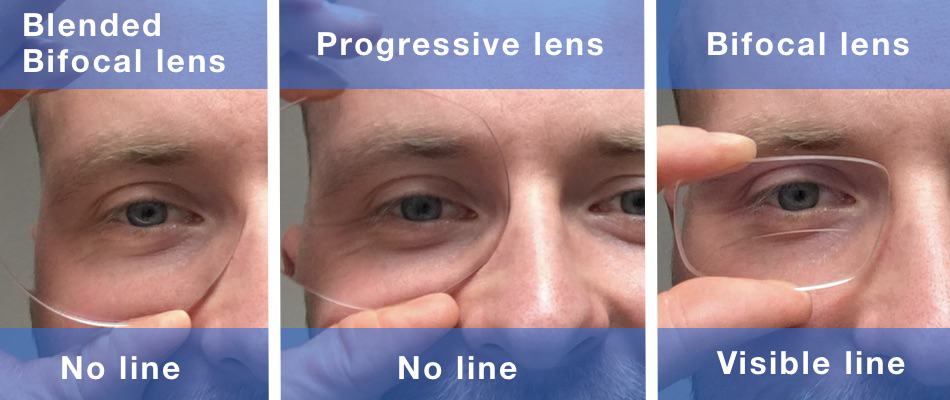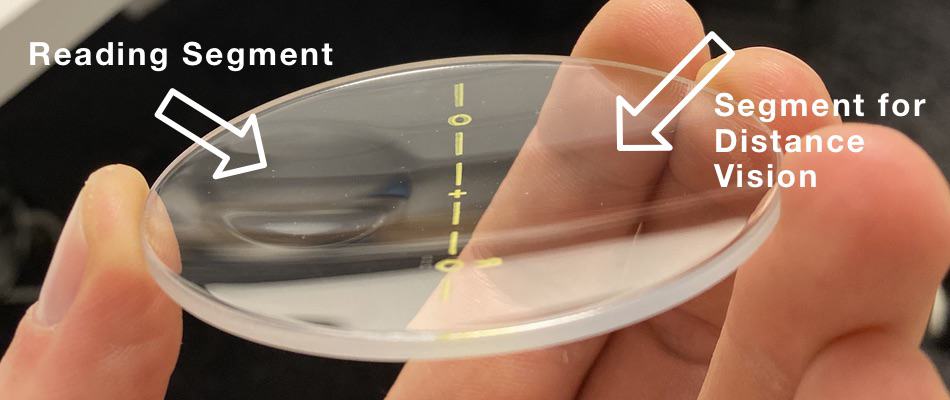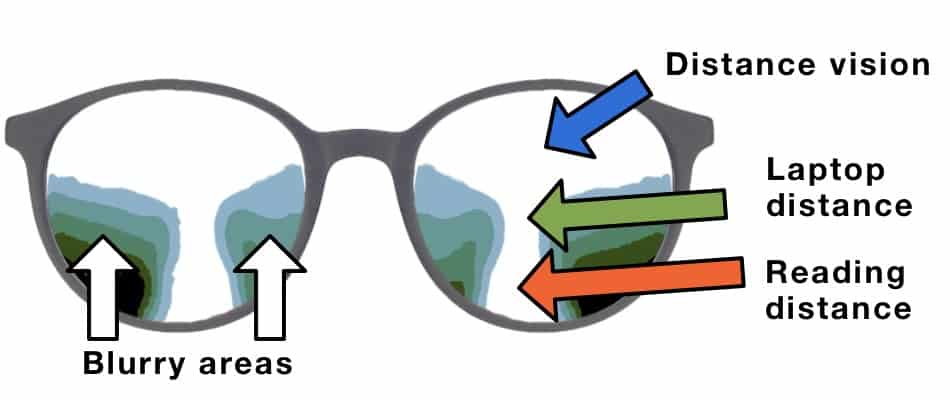If you are reading this article, you have probably been told that it is time to consider bifocals and are not a fan of the look of the line in the middle of your lenses. We have all seen our parents or grandparents wear them and they are not pretty. They were actually invented by Benjamin Franklin in the late 1700s!
Bifocals without the line are becoming more affordable and easier to find. Bifocal lenses are two different prescriptions in the same lens that help us see both near and far. There are multiple options for bifocal lenses, which include:
- Inner Bifocals (with line and with ledge)
- Fused Bifocals (with line and without ledge)
- Blended Bifocals (without the line and without ledge)
- Progressive Lenses (without the line and without ledge)
In an effort to save you some time and aggravation scouring the web for options, I have compiled the following list of common options available and what they mean.

Bifocal Lenses for Traditional Frames
If you already wear traditional glasses and are comfortable with your look, you have the option of getting no-line bifocal lenses for your glasses.
These hidden bifocal, clear lenses can help your vision and will look like you are wearing your regular glasses. There are different types of hidden bifocal lenses depending on what you prefer.
Inner Bifocals
This type of bifocal lens is designed exactly how the name suggests. The bifocal is placed on the inside of the lens. You will be able to see the line, but the line will be faint or undetectable to everyone around you.
You will clearly see where the line separates the clear part of the lens and the reader part of the lens. Some people adjust to this easily and others do not like seeing the line in their peripheral vision.
Blended Bifocals
Blended bifocal lenses are similar to inner bifocal lenses in that the line is placed on the inside of the lens. The difference in the blended lens is that the line is “smoothed” out. Think about buffing or sanding down a rough surface area.

This makes the transition from the clear part of the lens to the reader part of the lens more gradual. The “line” will look a little blurry, but it is only about a millimeter so your eyes should be able to adjust relatively quickly.
This is a good option for you if you do not want to see the line as much as you would with the inner bifocal option. Other people will not be able to see it, either.
Progressive Lenses
Progressive lenses are the true “no-line” lenses. They are designed for continuous wear, so they are “multifocal” lenses that eliminate bifocal and trifocal lines. What are they and how do they work?
Because your lenses are fitted to your individual eyes using measurements, the corridor of progressive lenses will allow you to adjust the power naturally rather than trying to find the right lens to look through.

Progressive lenses have three main vision areas:
- Top of the lens
- The middle of the lens
- The bottom of the lens
Types of Progressive Lenses
There are two different types of progressives that are based on the size frames you choose. With progressive lenses, you will choose your frames first and have the lenses customized to fit. Here are the two types of lenses:
Soft Design (most common lens design nowadays)
This design is recommended when the lens size of the chosen frame is more than 27 mm from top to bottom. Spacing like this offers a wider and longer field of view at middle-range distances.
The Soft Design also provides a more natural field of vision because of less distortion in the peripheral view of the lens. It works well for people over 50 with more severe vision issues due to presbyopia.
Hard/Short Corridor Design
In comparison to the Soft design, the hard/short design is slightly clearer when it comes to the distance zone because there are virtually no distortions in the line of sight.
This design also allows for smaller frames because of the shorter vertical measurements. This design is effective for people in the younger age ranges who do not need the intermediate-range correction.
Because progressive lenses have multiple powers in the same lens, they must be the correct size vertically. This is called the vertical corridor. This corridor is where the intermediate vision is corrected. Based on your individual situation, your doctor can help you decide how large or small this corridor should be.
Progressive lenses are also popular due to their ease of adaptability. Because of the multifocal powers in one lens, it is easier for your brain to adjust to the change automatically, rather than trying to focus on where to look with traditional bifocal lenses.
Bifocal and Multifocal Contacts
We have come a long way with technology since the 1700s, have we not? Yes, there are now bifocal and multifocal contact lenses.
Bifocal and multifocal contact lenses are exactly the same prescriptions as they are with traditional lenses that go into regular frames. Due to the size of contact lenses, however, they are designed differently. There are two different types of designs and functions.
Concentric Multifocal Contacts
Concentric means circular. This lens design uses rings around the entire lens to correct both distance and close-up vision. The goal of these “bulls-eye” type rings is to help make the transition from near to far feel more natural to your eyes. The location of the power within these rings may vary depending on your vision needs.
They are available in either soft, disposable material or the harder gas permeable material that can last up to two years with proper care. The table below depicts the different options:
| Gas Permeable contact lenses | The power located in the center of the lens is usually for distance |
| Dual Concentric Lenses | Two different power locations: distance is located in the center for the dominant eye and near in the center for the non-dominant eye. |
| Soft Lenses | Can have either the near or distance power in the center of the lens |
Aspheric Multifocal Contact Lenses
As the name suggests, “aspherical” means a slight deviation from a perfect sphere shape. With these lenses, there is more of a smooth transition of power from near to far, or vice versa. Aspheric lenses have a more gradual change in power than concentric lenses and are very similar to progressive lenses for this reason.
With regular eyeglasses, you can consciously move your eye to find the correct power depending on what you are looking at. With these lenses, your brain will have to adjust to the lens.
These contact lenses must be custom fitted so they can be somewhat costly.
Which Contact Lens Should I Choose?
The answer to this question comes down to you and your doctor. When it comes to contact lenses, there are a couple of factors your doctor will consider. The size of your pupil and your near prescription.
There is no one-size-fits-all approach, and it depends on your specific eye condition and health. Usually, the aspheric lenses work well for mild cases of presbyopia, and concentric ones work well for severe cases.
Due to some of the costs involved, your doctor may be able to recommend one way or the other.
Conclusion
Now that you know what some of your options are when shopping for no-line bifocals,
you should speak to your doctor about what he or she recommends will work for your individual needs.
Once you have chosen your option, you will need time to adjust to your new eyes. It could take days or weeks so give it some time before you give up.
Although there is a fashion component, your eye health must come first.
